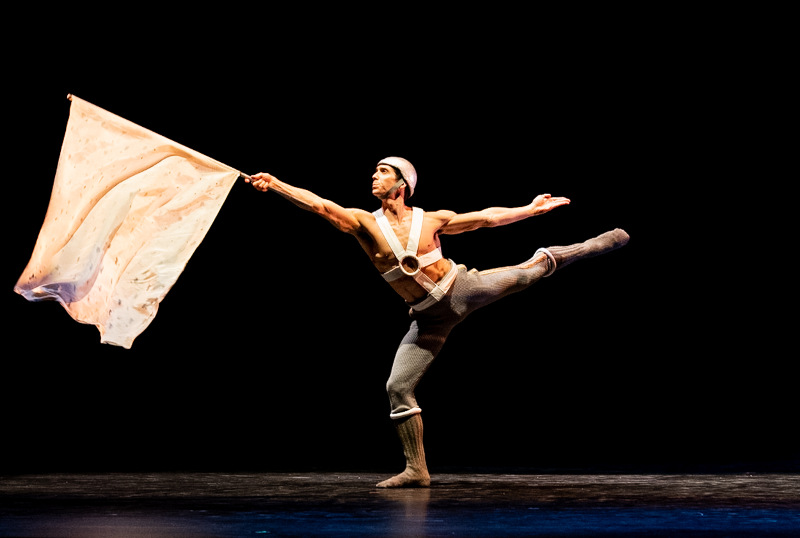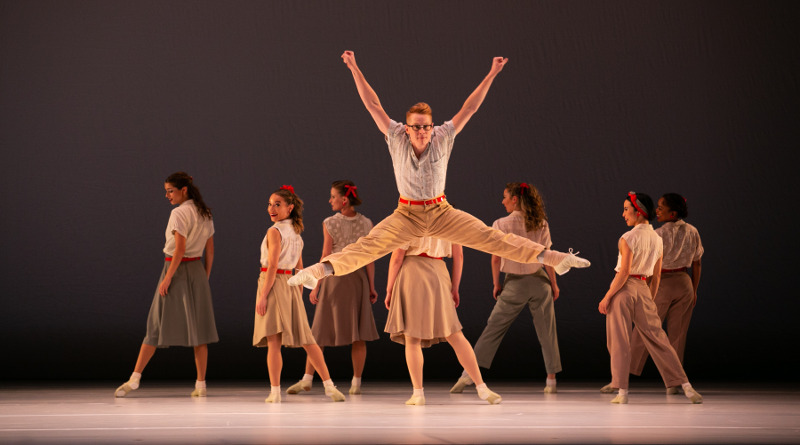
Who signed off on the venerable Paul Taylor Dance Company’s repertory-mix shared with fans at the Los Angeles Music Center this weekend? What should have been a joyous Los Angeles reunion with one of the nation’s longest-lasting dance companies (it dates from 1954!) felt like modern-dance homework. This show, in its totality, did not connect.

The audience voted with its feet. The repertory, as announced, failed to inspire Los Angeles dance lovers to trek downtown; only stalwarts populated Friday night’s opening of a three-concert run. Senõr Covid had a hand in this; we all know that. But dry toast on the smorgasbord did not help much either: A much-seen Taylor work, Company B, the selection of which felt like pandering; a world premiere by a young choreographer, Lauren Lovette, that’s nice, but it also means a toss of the dice on an unknown; and then, hey, get your jollies on The Green Table, the anti-war ballet dating from 1932, must-viewing especially if you missed CNN before leaving the house. This is not to deprecate any of those works on a standalone basis; it is to deprecate their bundling into a performance package. Eat your vegetables, dance fans, or you cannot leave the Dorothy Chandler Pavilion!
Lauren Lovette’s newest work for the company (she has spawned one after another as the Taylor Company’s new resident choreographer), Dreamachine, was the anticipated world premiere. It came on the program as the middle work of three. I was pleasantly surprised by Lovette’s full-bodied, well-tempered dance expression. Dreamachine‘s first two sections are choreographies of intrigue. A third needs to either return to the drawing board or hit the cutting room floor; it did not cohere.
Set to Michael Daugherty’s 2014 percussion concerto, a 30-minute score that hearkened movie music (he had no bio in the program); handsome costumes by Santo Loquasto (ditto); and lighting by Jennifer Tipton (ditto, but Tipton, in the house, was acknowledged on the Chandler stage for her Dreamachine lighting apparatus: four to five sinking bars of white neon light), Taylor dancer Kristin Draucker, dressed in a beautiful orange dress that suited her well, parried with a posse of foot soldiers bedecked in a dance version of metallic armor. Yes, a futuristic, Star Wars-y, video-game-warrior look come alive. Really an odd sight — and I liked it. Gorgeous costumes, in fact. The helmets and face guards? Perhaps too much, but facelessness has found new favor after our masked COVID existence. Interacting with this odd community, Draucker moved in an assured fashion, executing some sexy hip-swaying to the sound of xylophone and marimbas. The soldier-figures clustered in formations at center stage, piling into pyramids, and a tone of bombast surfaced. It is unclear whether Draucker was endangered, pitted solo as she was against this strange mob. I found the dance quite engaging, kind of smooth-sailing and organic – also, did I catch a few fleeting choreographic quotings from Paul Taylor? Little motifs? I was on board.
Dreamachine’s second segment was a duet. Two tall dancers, Jessica Ferretti and Kenny Corrigan (an Anthony Perkins look alike), both clad in verrrrry skin-tight denim jeans with the requisite shredding at the knees, he in an oversized white shirt, she in a bare-midriff top, noodled through balletic poses and athletic walk-overs, to dreamy music. The gentleman’s sliding arrival (spoiler alert) on special winged heel instigated the intriguing and nicely mysterious pas de deux. But the woman was unequivocally out front.
The corps de ballet in military fatigues and sun glasses of Dreamachine’s third section may be in keeping with the program’s antiwar theme. Lovette here seemed to be grasping, at loose ends. As a choreographer, when you find yourself asking dancers to vibrate hands to embody the sound of a snare drum, that may be the time to back off.
The program opener, Company B, Paul Taylor’s nostalgic evocation of the Second World War era staged to nine songs by The Andrew Sisters, has never been a personal favorite. In one of those funny reversals, what is meant to be “light and fun with a dark undertone” missed the light-and-fun part. The piece got off to a shaky start-up, with wobbly landings from turns and a lack of dance precision. One was hard pressed to locate the great choreographer’s signature moves: the precise arms splicing space in abundant arcs, the skittering, scampering locomotion, the off-kilter, step-backward balance, as though in a fall, offset by a lifted front leg. The dancers seemed untethered to these important signposts, and a bit lost on the Chandler’s vast stage. Only when ‘Boogie-Woogie Bugle Boy’ John Harnage gave a bounding demonstration of how it’s done, did Company B pick up. Through his barrage of bouncing leaps, Harnage illustrated, with his body, Taylor’s buoyant journey through the fun song’s swingy rhythms. There’s so much joy in Taylor’s way of isolating little sound-quirks of the big-band orchestration. But the Andrew Sisters recordings, delivered via the less-than-sonic-perfection of the Chandler’s speakers, was so unpleasantly loud, plugging the ears was the only defense.
I’m hurting right now from the state of our world, so was not open to Kurt Jooss’s weighty The Green Table (1932). But I’m glad that young people can see the Taylor Company’s restaging of this historic work. My personal hope was that modern dancers would give a solid, well-anchored, shape-sensitive rendering of a work I have only seen performed by ballet companies. This did not come to pass. The positions and poses eluded the young Taylor dancers. The marching figure of Death is a fierce role—in rote danse-mecanique, he lifts leg to passe and slams foot to floor. In this merciless rinse-and-repeat, dancer Shawn Lesniak fell short. The best exponent of German Expressionism in dance was, once again, John Harnage, who, as “The Profiteer” nearly alone possessed the musculature to carve body shapes emblematic of corruption, greed. A work like “Green Table” needs to be full throttle, and a few of the stage crossings, for example by soldiers, felt lite. Too “pretendy.”
F.A. Cohen’s great, unheralded score for “Green Table” was performed live by two pianists in the pit—giving acoustic pleasure.
Kudos to Madelyn Ho. She’s a marvelous exponent of a vaunted tradition — the petite Paul Taylor female dancer.

That Madelyn Ho was quite the stuff. If there was one thing from the whole program that stuck with me it was her. She really made the most of everything and killed that Yankee Dollar thing. I think Dreamachine would have been better on an evening of new and non Taylor pieces.
Hi Deborah,
Hallelujah and Here! Here!. Pretty much agree with you.
Thanks for your honesty!